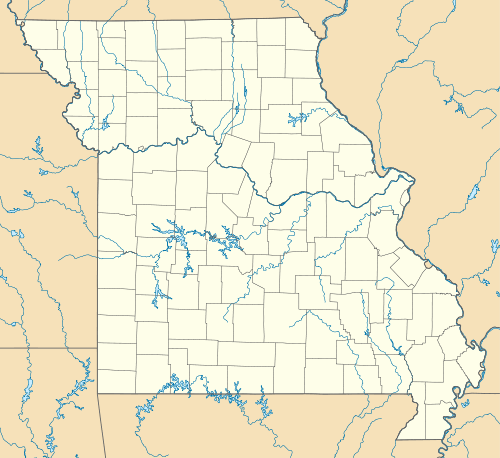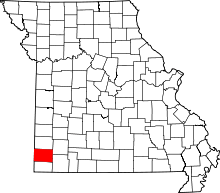Monark Springs, Missouri
| Monark Springs | |
|---|---|
| Ghost town | |
 Monark Springs Location within the state of Missouri | |
| Coordinates: 36°51′52″N 94°17′30″W / 36.86444°N 94.29167°WCoordinates: 36°51′52″N 94°17′30″W / 36.86444°N 94.29167°W | |
| Country | United States |
| State | Missouri |
| County | Newton |
| Time zone | Central (CST) (UTC-6) |
| • Summer (DST) | CDT (UTC-5) |
Monark Springs is a ghost town in Newton County, Missouri, United States. It is located about five miles east of Neosho and is now the site of a state conservation area.[1]
History
In August 1956, an outbreak of typhoid fever occurred in Monark Springs during a national Church of God campmeeting that had over 400 members from other states as far west as California and east to Kentucky, attending.[2][3] The cases continued to spread outside of the town after the meeting, with 16 reported cases cropping up in various parts of Missouri and Kansas.[4][5] CDC officials were sent to the camp site to investigate the water in the area, in order to determine the exact source of the outbreak.[6] It was eventually discovered that a carrier of typhoid fever had unknowingly contaminated the water in the well that had been used as drinking water for the entire camp site.[7]
A fire began in three separate spots on Halloween 1997 at Red's Tire Service in Monark Springs. (Not at Monark Springs, but between Neosho, MO and Joplin, MO.) The site had housed from 600,000 to a million tires and about half ended up being burned in the blaze. The owner of the site was investigated for arson because of the incident and later sued by the state, having to eventually sign an agreement with the state that reduced the number of tires he was allowed to keep at one time. The site had previously been important, as it was the "only waste-tire dump in southwest Missouri with a state permit".[8] The fires continued to smolder even seven months afterward, with Richard Allen, a "spokesman for the Missouri Department of Natural Resources", quoted saying, "It's the shredded tires that are still smoldering, and they probably will be for a long, long time."[9]
References
- ↑ "Ft. Crowder Conservation Area". Goby. 10 October 31, 2010. Check date values in:
|date=(help) - ↑ "TYPHOID HITS FAMILIES AT CHURCH MEET". Chicago Daily Tribune. August 26, 1956. Retrieved October 24, 2010.
- ↑ Jean Strouse (1956). "Monark Springs Typhoid Fever". Newsweek. 48 (1–13).
- ↑ "TYPHOID CASES GROWING AFTER CAMP MEETING". Chicago Daily Tribune. August 31, 1956. Retrieved October 24, 2010.
- ↑ "LINK 6 TYPHOID CASES TO CAMP; STUDY OTHERS". Chicago Daily Tribune. September 5, 1956. Retrieved October 24, 2010.
- ↑ Avery, Peter Van (1959). Public health. H.W. Wilson. p. 65. Retrieved October 24, 2010.
- ↑ National Research Council (U.S.). Committee on Salmonella; United States. Food and Drug Administration, United States. Dept. of Agriculture (1969). An evaluation of the salmonella problem. National Academy of Sciences. p. 80. Retrieved October 24, 2010. Cite uses deprecated parameter
|coauthors=(help) - ↑ "Neosho tire dump smolders, owner denies arson". The Nevada Daily Mail. November 4, 1997. Retrieved October 24, 2010.
- ↑ "Pile of Tires is Still Burning After Seven Months". Associated Press. June 7, 1998. Retrieved October 24, 2010.
Further reading
- William A. Neill; J. D. Martin; E. A. Belden; W. Yates Trotter (October 2, 1958). "A Widespread Epidemic of Typhoid Fever Traced to a Common Exposure". The New England Journal of Medicine. Massachusetts Medical Society. 259 (14): 667–672. doi:10.1056/NEJM195810022591403.
